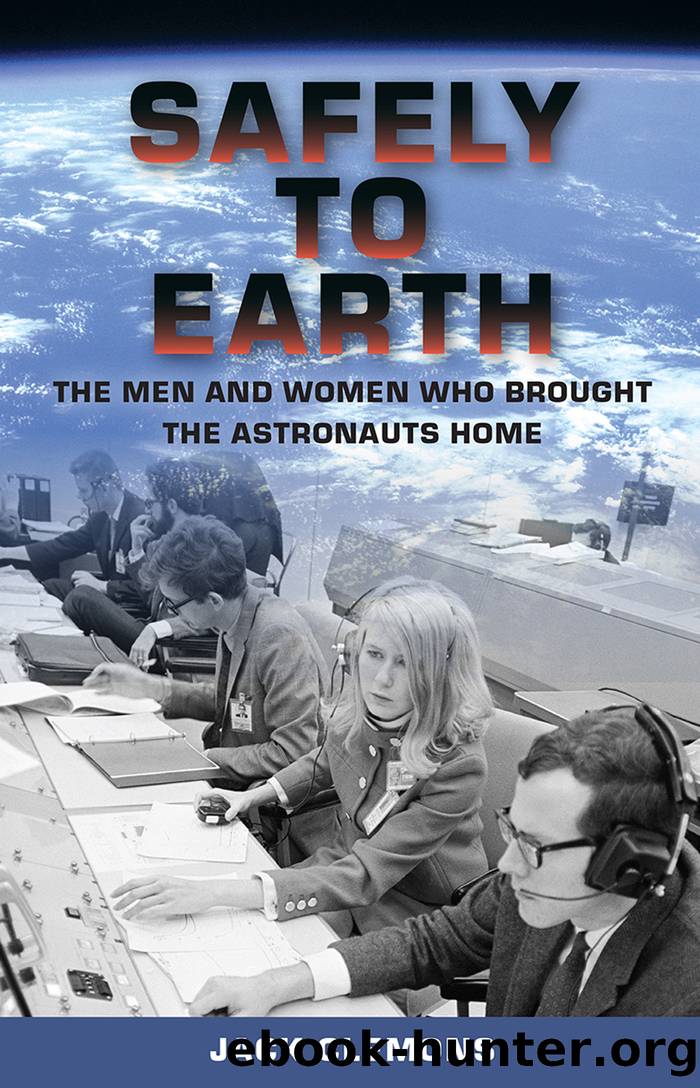Safely to Earth by Clemons Jack;

Author:Clemons, Jack;
Language: eng
Format: epub
Publisher: University Press of Florida
Published: 2018-08-15T00:00:00+00:00
Early concept designs for the Space Shuttle. NASA Image.
Human spaceflight requires a vastly greater demand for support than does an unmanned rocket. Beyond the payload carried aloftâa satellite, a scientific experiment, or an International Space Station module, for exampleâhumans need food and water and air and toilet facilities, as well as provisions for emergency medical care, protection from harmful radiation, and shelter from micrometeorite strikes. For extended stays, they also need some means to exercise. Accommodating all of that, plus the humans themselves, means that a lot of weight must be lifted into orbit.
Extremely powerful rockets, consuming enormous supplies of fuel, are required to produce sufficient thrust to climb the steep gravity well from the Earthâs surface to a height of 250 miles, the orbit of the International Space Station. The irony of this demand is that the rockets and fuel are themselves tremendously heavy, requiring even more thrustâand so it goes. NASA realized early on that short of an unprecedented revolution in rocket fuel developmentâsome as-yet-undiscovered substance that could produce more than a pound of thrust to the spacecraft for each pound of fuel consumedâthe only solution was to shed weight as you go. Starting with the Mercury-Atlas two-stage rocket that John Glenn rode into orbit in 1962, rocket fuel was partitioned into separable sections, each of which was discarded before the next stage was ignited. That way the spacecraft engines wouldnât have to lift the deadweight of the spent fuel casings.
A similar approach for the Space Shuttle resulted in the design of multiple expendable sources of fuel for a launch. To gain the maximum thrust during initial liftoff required three bell-shaped Main Engines located at the rear end of the Orbiter itself, plus an External Tank (ET) that carried the fuel for the Main Engines, and two Solid Rocket Booster engines (SRBs) that were mounted on either side of the External Tank.
The Shuttle Main Engines carried no fuel of their own; that was fed to them from the attached External Tank. The ET contained two internal fuel tanks, one holding liquid hydrogen and the other liquid oxygen. Their contents were delivered separately to the Shuttle Main Engines via a complex of pumps and pipes and valves. There they were combined and ignited, and then, like aircraft fuel, could be throttled, metered, and even shut down. The two SRBs attached to the External Tank burned solid fuel, a complex mixture of flammable compounds and stabilizers. They operated much like fireworks set off on the Fourth of July. Once lit they couldnât be turned off.
For a launch, the Shuttle Main Engines were started first. The Shuttle system was locked in place for an additional six seconds after the Main Engines ignited to give them time to build up thrust, and all systems were given a final check. Then the Solid Rocket Boosters were lit and their lock-down bolts exploded, and the Space Shuttle launched. The SRBs continued to burn until their fuel was spent. At that point they were separated
Download
This site does not store any files on its server. We only index and link to content provided by other sites. Please contact the content providers to delete copyright contents if any and email us, we'll remove relevant links or contents immediately.
| Aeronautics & Astronautics | Astronomy |
| Astrophysics & Space Science | Comets, Meteors & Asteroids |
| Cosmology | Mars |
| Solar System | Star-Gazing |
| Telescopes | UFOs |
Turbulence by E. J. Noyes(7057)
Tools of Titans by Timothy Ferriss(6965)
Astrophysics for People in a Hurry by Neil DeGrasse Tyson(4627)
Room 212 by Kate Stewart(4115)
Pale Blue Dot by Carl Sagan(4017)
The David Icke Guide to the Global Conspiracy (and how to end it) by David Icke(3891)
Secrets of Antigravity Propulsion: Tesla, UFOs, and Classified Aerospace Technology by Ph.D. Paul A. Laviolette(3543)
Apollo 8 by Jeffrey Kluger(3205)
Losing the Nobel Prize by Brian Keating(3188)
A Journey Through Divination and Astronomy by Publishing Pottermore(3151)
Goodbye Paradise(2976)
COSMOS by Carl Sagan(2959)
Brief Answers to the Big Questions by Stephen Hawking(2883)
How to Read Water: Clues and Patterns from Puddles to the Sea (Natural Navigation) by Tristan Gooley(2873)
The Five People You Meet in Heaven by Mitch Albom(2849)
The Order of Time by Carlo Rovelli(2727)
How to Read Nature by Tristan Gooley(2668)
A Brief History of Time by Stephen Hawking(2480)
Aliens by Jim Al-Khalili(2387)
